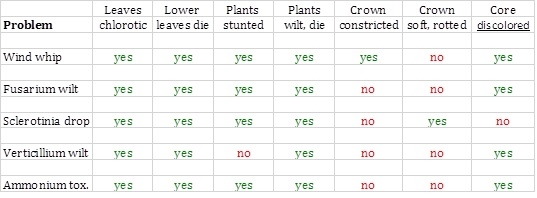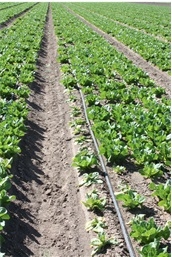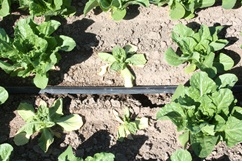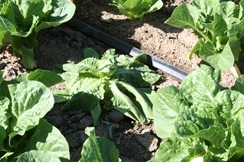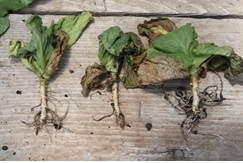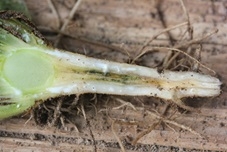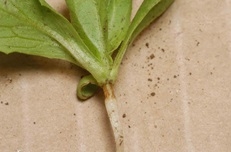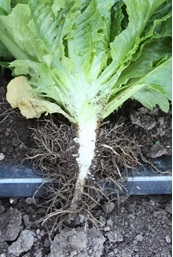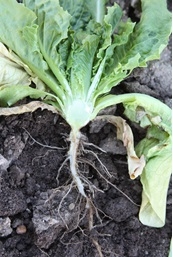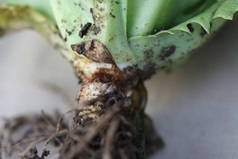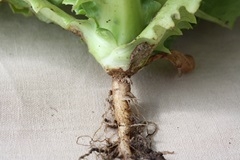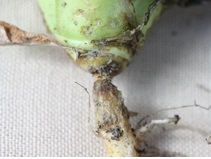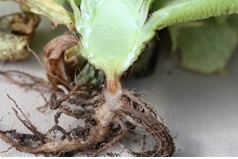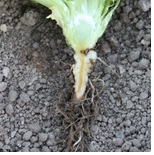In the past week there have been a large number of lettuce samples from diverse parts of Monterey County submitted to our office with damage to the roots that looks like wind whip. Wind whip is an issue that we normally see to a small extent each year at certain times of the season in the Salinas Valley. However, the level of damage that growers and PCAs are reporting right now is higher than we normally see (e.g. 10 to 30%).
Wind whip is usually a short lived phenomenon in lettuce production fields. It typically is initiated during thinning when divots are cut to remove unwanted plants. If the divot is too deep or too close to the lettuce plant, it can lean excessively to one side or the other or actually twist. In either case the hypocotyl between the soil level and the base of the plant can get pinched which can be either lethal or have sub lethal effects on the plant. Given the high winds that we experience in the Salinas Valley, it is quite amazing that we do not see more damage to lettuce fields from wind whip.
According to the King City CIMIS weather station there were particularly strong winds on January 30 and February 9, 11 and 24. Many of the fields that were affected were thinned around or before these dates. It is interesting that most of the samples that we received came into the office between February 25 and March 1 indicating when the symptoms became obvious to the growers and PCAs. It appears that symptoms developed slower on this “winter” grown lettuce than it normally develops during summer months.
The wind whip samples that we saw in the field looked a bit like fertilizer burn or ammonium toxicity due to stunting, yellowing and wilting of the plants (Photos 1 – 5) (see Table 1). Upon close examination of the plants, they all had roots that were impaired by the constriction at the crown of the plant. The herbicide Goal can cause damage to the crown of the plant (Photo 6), but there was no Goal used on any of the beds with the wind whip issue that we have received to date.
Wind whip also shares some symptoms in common with soilborne diseases of lettuce. The closest match is probably Fusarium wilt, which likewise causes lettuce to be stunted, chlorotic, and wilted in late stages of disease development. Both wind whip and Fusarium wilt cause the inner core of crown/taproot to become discolored. However, Fusarium wilt in our county is a mid- to late-summer disease; it is very unusual to have Fusarium wilt of lettuce in February. Early development of Sclerotinia lettuce drop can also cause lettuce to fall behind in development, turn yellow, and collapse. Lettuce drop, however, always causes the crown to be soft and decayed, with white mycelium and black sclerotia present. See Table 1 for a summary and comparison of these symptoms.
Table 1. Comparison of wind whip and soilborne disease symptoms
Wind whip symptoms varied from slight (Photo 7) to increasingly severe to severe (Photos 8-11). The functioning of the roots is impaired by the constriction and damage to the phloem. As a result the roots often are stunted and have discolored cores indicating stress (Photos 12-13). As the roots lose their ability to function, the plant cannot grow normally and is stunted.
Wind whip appeared to be worse on east-west fields, and appeared to be worse on romaine vs head lettuce. One question that we were not able to settle was if wind whip was less severe on auto thinned fields due to the lack of disturbance of the beds in the thinning process.
The widespread occurrence of wind whip in the last few weeks appears to be literally a perfect storm of high winds and susceptible lettuce. Hopefully the rest of the year will not have as severe of conditions.
